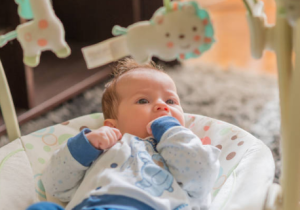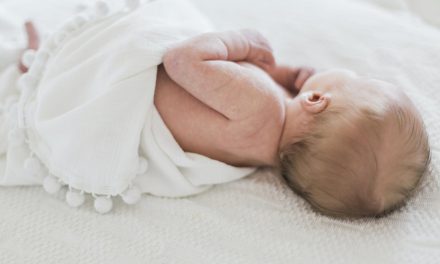There’s no doubt that the baby swing gives the parents’ arms a much-needed rest. After all, caring for babies is a lot of work, in part because they have a strong need to shake and hold.
While some babies are willing to hang out in their cribs or baby seats when they are not sleeping or feeding, others crave more exercise and become irritable if they don’t shake or walk. This is normal behavior for babies, and there is nothing wrong with holding your baby as much as possible.

But most of us can’t hold our baby all the time, which is why baby swings are so useful. Baby swings hold your baby when you’re weak, and they provide a motor stimulus that can soothe your baby. They also help to relieve your baby’s irritability and keep your baby in a happy mood.
Still, many of us are confused about baby swings and wonder if they are a bad thing or maybe overused. Below we’ll answer all your questions about baby swings, including everything from benefits and risks to important safety tips to remember.
Benefits of Baby Swings
Babies are born with little independence, they are heavily dependent on their parents as they are in the womb. They also miss the environment in their womb, which is why they like to be wrapped, shaken, and quiet. All these activities remind them of the comfort in the womb.
While most parents just want to provide this type of comfort to their baby around the clock, it’s nearly impossible to hold, shh, and shake your baby 24/7. While some babies are content without the need for these activities, others – especially those who experience colic or are very fussy – need this type of reassurance all the time!
For new parents, a baby swing is like a lifeline. Most baby swings give a comfortable feel to the baby, can shake the baby, and can even provide music, boos, and other audio or visual entertainment such as lights or cell phones. Although not all babies enjoy swings, many parents find that this is the only place where they can put their baby down while he is awake.
Disadvantages of Baby Swings
In most cases, baby swings are a lifesaver for parents. However, there are certain pitfalls that you should be aware of. First of all, although rare, some babies just don’t like to spend time on baby swings and tend to become more fussy on them.
These babies may find the swing uncomfortable or may be overstimulated by lights, sounds, or movements. Consider different shaking settings, different audio settings, or placing your baby on the swing at different times of the day.

Some parents may also become overly reliant on baby swings. They may use the swing every time your baby is making a fuss and won’t learn other ways to soothe your baby. Instead, change your baby’s soothing techniques. Before placing your baby on the swing, make sure they aren’t hungry, need to go to bed, or have other needs you may have overlooked.
The American Academy of Pediatrics states that babies should not rely too much on swings or other baby seats to avoid daily prone exercises, which are essential for their development. They also warn that staying on a baby swing or other baby seat for too long may flatten your baby’s head.
Baby Swings and Baby Sleep
The most surprising thing you may learn about baby swings is that they are not suitable for use while your baby is sleeping. This may be the opposite of the baby swing you may have heard of.
If your baby falls asleep on the swing, you don’t need to panic, but you should transfer them to the crib as soon as possible. It is safest when your baby is sleeping on his back on a flat surface. This is more than just a guide to baby swings. Infants are also not suitable for sleeping in car seats, inflatable seats, or strollers.
This is because, babies who sleep upright are at a higher risk of choking if they are head-down or their breathing is affected, especially if the caregiver is not watching carefully.
Research published by the American Academy of Pediatrics found that babies die from sleeping on a seat such as a baby swing, stroller, or car seat. Of the 11,779 infant deaths studied, 3% (348 deaths) occurred in the seat, of which 35% occurred in the infant swing.
Safety Precautions for Baby Swings
It is crucial to take safety precautions when using a baby swing. Although rare, babies have been injured while using baby swings, and some have even died as a result of unsafe practices. To this end, the AAP has developed a series of safety rules that all parents should follow when using the baby swing.
AAP Guidelines for the Safe Use of Infant Swings
AAP safety tips for infant swing use include:
- For babies 4 months and younger, always use the most inclined position on the swing.
- Make sure the swing is sturdy and won’t tip over or fold easily.
- Use the safety belt provided so that your baby does not fall off the swing.
- Keep toys and cell phones away from your baby.
- If your baby no longer fits, stop using the swing and check that your child has exceeded the manufacturer’s weight limit.
- Make sure the cradle of the swing is flat during exercise so that your baby doesn’t fall off.
In addition to these AAP tips, make sure to never place your baby’s swing on a high surface, such as a kitchen counter or coffee table. You should also avoid placing the blanket on the swing with your baby as there is a choking hazard. Instead, dress your baby in layers of clothing, stay in the same room as your baby on the swing, and observe them carefully.

When Do Babies No Longer Need Swings?
Similarly, when it comes to the time of use of the baby swing, you should read the manufacturer’s guidelines. Once your baby has exceeded the stated height and weight limits, you should stop using the swing. You may even be reminded when your baby is done playing on the swing.
For example, when the swing no longer brings them comfort or entertainment, they may refuse to put it in, or immediately cry. It’s your hint that they’re no longer interested, and that the swing may not be the perfect place for them.
What to Look for When Buying a Baby Swing?
When you’re planning to buy a baby swing or put it on your check-in list, here are a few things to keep in mind. Here are the things to consider before buying.
Decide which features you want. Most babies are happy with the basic swings. After all, sports are their favorite. But if your budget allows, you can go all out with other features, especially if they make your life easier.
Consider the size of your space. Also, consider the size of your home and your lifestyle. Many parents prefer baby swings that can be easily carried from room to room. In this case, it may make the most sense to buy a smaller, more portable model.
Test the swing first. Before buying a baby swing, observe the swing in the store or watch an online video to see what it looks or sounds like. Make sure the music and visuals are satisfying to you, especially since you’ll probably spend hours watching and listening to this content every day.
Baby Swings Recalled
As with any baby product, be aware of recalls, especially if you are using an old swing. For new swings, register your purchase with the manufacturer to receive an alert if your swing is recalled.
There have been a number of high-profile cases of infant swing recalls related to safety issues, including manufacturing defects that caused the swing to tip over. There are also problems with the restraint device or tray for the swing.
Since recalls are often due to safety concerns, take baby swing recalls seriously. If you’re curious about the safety of current baby swings, you can also check the recall status with the U.S. Consumer Product Safety Commission.






